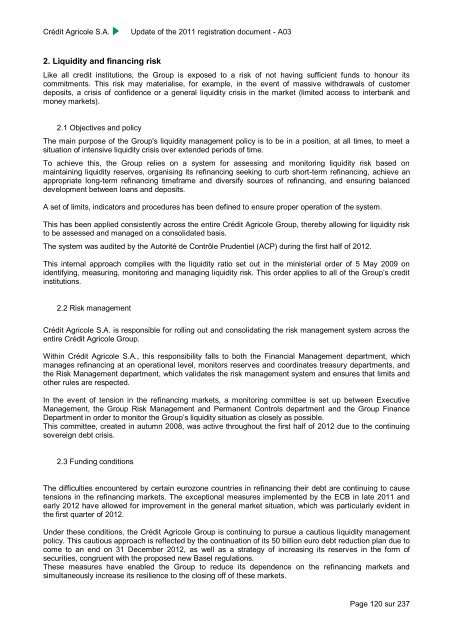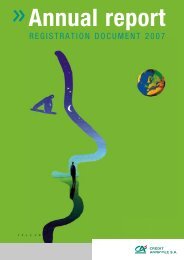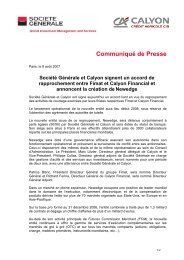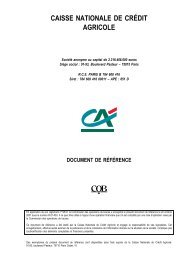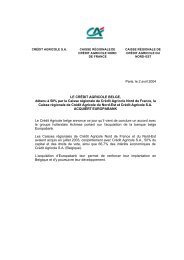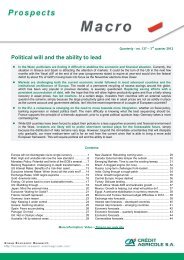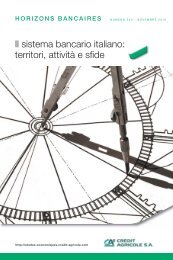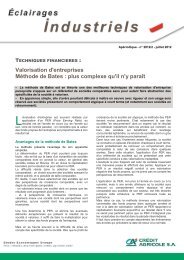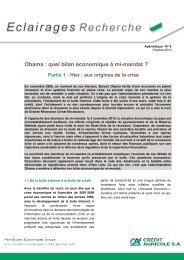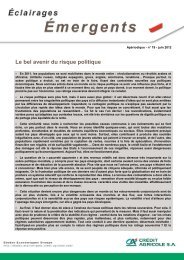PDF (3.77 Mo) - Le Crédit Agricole
PDF (3.77 Mo) - Le Crédit Agricole
PDF (3.77 Mo) - Le Crédit Agricole
You also want an ePaper? Increase the reach of your titles
YUMPU automatically turns print PDFs into web optimized ePapers that Google loves.
Crédit <strong>Agricole</strong> S.A.Update of the 2011 registration document - A032. Liquidity and financing riskLike all credit institutions, the Group is exposed to a risk of not having sufficient funds to honour itscommitments. This risk may materialise, for example, in the event of massive withdrawals of customerdeposits, a crisis of confidence or a general liquidity crisis in the market (limited access to interbank andmoney markets).2.1 Objectives and policyThe main purpose of the Group's liquidity management policy is to be in a position, at all times, to meet asituation of intensive liquidity crisis over extended periods of time.To achieve this, the Group relies on a system for assessing and monitoring liquidity risk based onmaintaining liquidity reserves, organising its refinancing seeking to curb short-term refinancing, achieve anappropriate long-term refinancing timeframe and diversify sources of refinancing, and ensuring balanceddevelopment between loans and deposits.A set of limits, indicators and procedures has been defined to ensure proper operation of the system.This has been applied consistently across the entire Crédit <strong>Agricole</strong> Group, thereby allowing for liquidity riskto be assessed and managed on a consolidated basis.The system was audited by the Autorité de Contrôle Prudentiel (ACP) during the first half of 2012.This internal approach complies with the liquidity ratio set out in the ministerial order of 5 May 2009 onidentifying, measuring, monitoring and managing liquidity risk. This order applies to all of the Group’s creditinstitutions.2.2 Risk managementCrédit <strong>Agricole</strong> S.A. is responsible for rolling out and consolidating the risk management system across theentire Crédit <strong>Agricole</strong> Group.Within Crédit <strong>Agricole</strong> S.A., this responsibility falls to both the Financial Management department, whichmanages refinancing at an operational level, monitors reserves and coordinates treasury departments, andthe Risk Management department, which validates the risk management system and ensures that limits andother rules are respected.In the event of tension in the refinancing markets, a monitoring committee is set up between ExecutiveManagement, the Group Risk Management and Permanent Controls department and the Group FinanceDepartment in order to monitor the Group’s liquidity situation as closely as possible.This committee, created in autumn 2008, was active throughout the first half of 2012 due to the continuingsovereign debt crisis.2.3 Funding conditionsThe difficulties encountered by certain eurozone countries in refinancing their debt are continuing to causetensions in the refinancing markets. The exceptional measures implemented by the ECB in late 2011 andearly 2012 have allowed for improvement in the general market situation, which was particularly evident inthe first quarter of 2012.Under these conditions, the Crédit <strong>Agricole</strong> Group is continuing to pursue a cautious liquidity managementpolicy. This cautious approach is reflected by the continuation of its 50 billion euro debt reduction plan due tocome to an end on 31 December 2012, as well as a strategy of increasing its reserves in the form ofsecurities, congruent with the proposed new Basel regulations.These measures have enabled the Group to reduce its dependence on the refinancing markets andsimultaneously increase its resilience to the closing off of these markets.Page 120 sur 237


